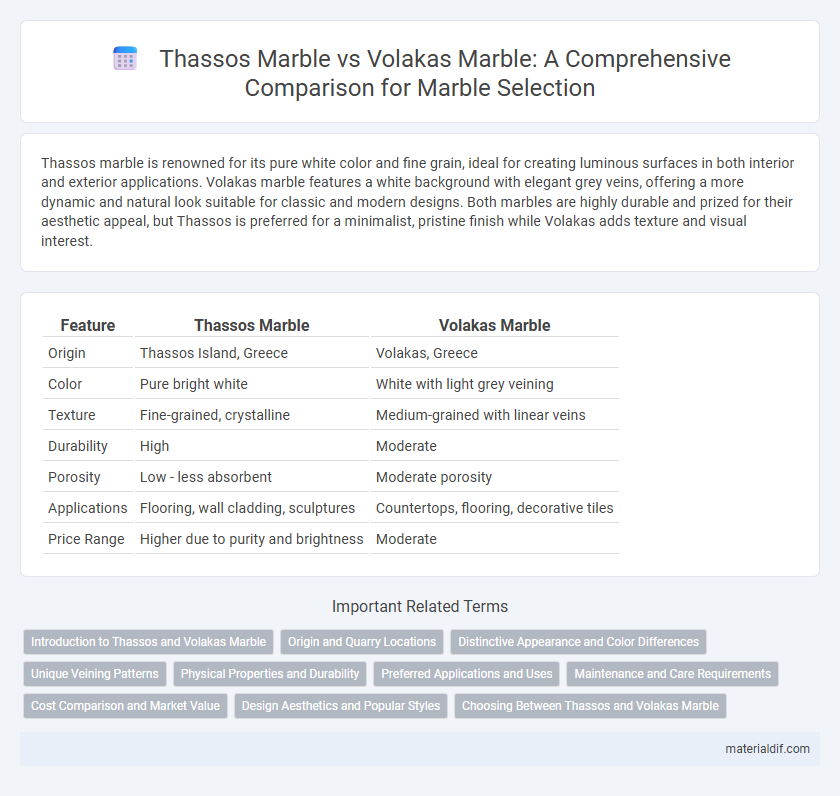Thassos marble is renowned for its pure white color and fine grain, ideal for creating luminous surfaces in both interior and exterior applications. Volakas marble features a white background with elegant grey veins, offering a more dynamic and natural look suitable for classic and modern designs. Both marbles are highly durable and prized for their aesthetic appeal, but Thassos is preferred for a minimalist, pristine finish while Volakas adds texture and visual interest.
Table of Comparison
| Feature | Thassos Marble | Volakas Marble |
|---|---|---|
| Origin | Thassos Island, Greece | Volakas, Greece |
| Color | Pure bright white | White with light grey veining |
| Texture | Fine-grained, crystalline | Medium-grained with linear veins |
| Durability | High | Moderate |
| Porosity | Low - less absorbent | Moderate porosity |
| Applications | Flooring, wall cladding, sculptures | Countertops, flooring, decorative tiles |
| Price Range | Higher due to purity and brightness | Moderate |
Introduction to Thassos and Volakas Marble
Thassos marble is renowned for its pure, bright white color and fine grain, making it highly sought after for luxurious architectural and sculptural applications. Volakas marble, characterized by its creamy white base with elegant gray and beige veining, offers a distinctive aesthetic that adds warmth and sophistication to interiors and facades. Both marbles originate from Greece, with Thassos quarried on Thassos Island and Volakas primarily extracted in the regional unit of Volakas, reflecting unique geological formations and visual appeal.
Origin and Quarry Locations
Thassos marble originates from the island of Thassos in the northern Aegean Sea of Greece, known for its pure white and crystalline appearance. Volakas marble is quarried in the Kavala region of northeastern Greece, featuring elegant white tones with soft grey or beige veining. Both marbles come from distinct geological formations, influencing their unique textures and aesthetic appeal.
Distinctive Appearance and Color Differences
Thassos marble is renowned for its pure, bright white color and fine-grained texture, making it a popular choice for elegant interiors and sculptures. In contrast, Volakas marble features a creamy white base with elegant grey veining, imparting a more dynamic and natural look. The distinct color uniformity of Thassos contrasts with the varied patterns of Volakas, offering designers diverse aesthetic options based on project requirements.
Unique Veining Patterns
Thassos marble is renowned for its pure white color with subtle and delicate grey veining patterns that create a clean, minimalist aesthetic. Volakas marble features more pronounced and dynamic veining, with bold swirls and veins in shades of grey and gold, offering a more dramatic and luxurious appearance. The distinct veining patterns in Thassos and Volakas marble provide unique decorative options for architectural and interior design projects seeking either understated elegance or striking visual impact.
Physical Properties and Durability
Thassos marble is renowned for its pure white color and high density, offering excellent resistance to weathering and physical wear, making it ideal for both indoor and outdoor applications. Volakas marble features a white base with gray to brown veining, exhibiting lower density than Thassos marble but still providing good durability suitable for decorative interior uses. Both marbles have a Mohs hardness of around 3-4, but Thassos marble's higher calcite content enhances its strength and longevity compared to Volakas marble.
Preferred Applications and Uses
Thassos marble, known for its pure white color and fine grain, is preferred for luxury interior applications such as flooring, wall cladding, and countertops in high-end residential and commercial projects. Volakas marble features a creamy white base with delicate grey veining, making it popular for decorative elements, bathroom vanities, fireplace surrounds, and sculptural works. Both marbles are widely used in architectural design, but Thassos is favored for bold, minimalist aesthetics, while Volakas suits classic and elegant styles.
Maintenance and Care Requirements
Thassos marble, known for its pure white color and dense structure, requires regular sealing to prevent staining and maintain its polished finish, especially in high-traffic areas. Volakas marble, characterized by its white background with gray to light brown veining, demands more frequent cleaning with pH-neutral products to avoid etching and discoloration. Both types benefit from prompt spill cleanup and avoiding acidic substances to preserve their natural beauty and longevity.
Cost Comparison and Market Value
Thassos marble, known for its pure white color and high density, generally commands a higher market value compared to Volakas marble, which features subtle grey veining and a softer texture. The cost difference is driven by Thassos marble's rarity and superior durability, making it a preferred choice for luxury projects. Volakas marble offers a more affordable option while still maintaining aesthetic appeal, making it popular for mid-range applications.
Design Aesthetics and Popular Styles
Thassos marble is renowned for its pure white color and fine grain, making it a popular choice for creating sleek, modern design aesthetics and minimalist interiors. Volakas marble features elegant white bases with distinctive gray veining, often used in classic, luxurious styles and sophisticated countertops. Both marbles are favored in high-end residential and commercial projects for their unique visual appeal and ability to complement contemporary and traditional design schemes.
Choosing Between Thassos and Volakas Marble
Thassos marble is renowned for its pure, bright white color and high-reflective surface, making it ideal for luxurious interiors and modern designs seeking a clean, minimalist look. Volakas marble, characterized by its white background with elegant gray veining, offers a more dynamic and classic appearance suitable for both traditional and contemporary settings. Selecting between Thassos and Volakas marble depends on desired aesthetic and project requirements, with Thassos favored for uniform brightness and Volakas chosen for subtle veining and natural texture.
Thassos Marble vs Volakas Marble Infographic

 materialdif.com
materialdif.com